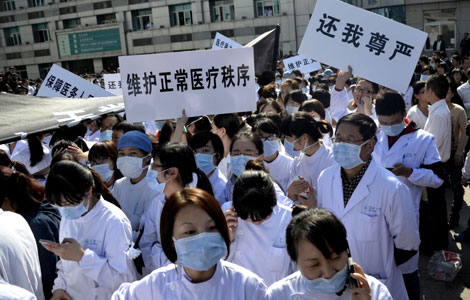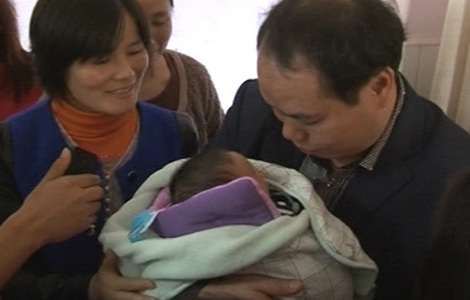Premier vows local governance reforms
Updated: 2013-11-09 02:08
(China Daily)
|
|||||||||||
III. Local institutional reform should focus on "control, adjustment and change".
One old saying has it that, "A good government is a slim government". This round of local government institutional reform must ensure success in "exercising control, making adjustment and promoting change". "Control" refers to strictly controlling the total size of government staff. "Adjustment" refers to making adjustments and improvements to the personnel structure. And "change" refers to unleashing staff potential through deepening reform.
1. The size of government staffing must be put under rigorous control. In this round of reform, we must observe two principles:
one is to set a limit on the total number of local government agencies in order to control government size; the other is to make sure government payroll will only shrink and not expand. This is a commitment this government has made to the entire population. Difficult as it is, a promise is a promise and we will honor it with good faith. Why do we need to strictly control the size of government staffing? Given the current situation, government revenues at various levels are unlikely to see fast growth as in the past. With a large payroll, we will, more often than not, end up in a situation where the little produced by the few will soon be depleted by the many who consume. In just half a year since the formation of this government, some localities and departments have again asked to increase their staffing. Without control, the problem will go from bad to worse. The size of government staffing is already very big. Duplicating responsibilities and overlapping portfolios will not only lead to inefficiency, but even breed corruption. It will tarnish government image and dampen the enthusiasm of those hardworking civil servants. Eventually, it is the interest of the people that is at stake.
2. The organization and staffing structure of government agencies should be adjusted and improved. The problem at hand is not insufficient size, but poor structure and a misallocation of resources in terms of organizational setup and staffing. On the one hand, there is a shortage of hands in those key areas and links that should be strengthened, and government responsibilities that should be taken care of are even left unattended. On the other hand, in areas already identified as requiring less government attention, the agencies fail to streamline accordingly, resulting in overstaffing. While capping the overall size, we should also see the great potential in adjusting and improving the organizational and staffing structure of government agencies and public institutions. Over the past two years, we have been advancing reform of public institutions based on different categories and have removed some agencies and positions through rectification and regulation. Right now, some government agencies have fat bodies and thin legs, like an ostrich. Local governments must be determined to strengthen those institutions that should be strengthened and scale back those where it is necessary. In particular, the grassroots level and the frontline of government institutions should be fortified. When we make adjustments to the organizational and staffing structure, we have to give consideration to the need of slimming down higher-level governments while beefing-up those at the grassroots level.
3. Reform should be deepened to meet our needs for development. To control the size and adjust the structure of government agencies and staffing, the key is to deepen reform and innovate management. Experience over the years shows that without reform and innovation, it is very difficult to break the vicious cycle of streamlining-swelling-streamlining again-swelling again. In recent years, some localities have made good and effective explorations in institutional reform. Some have consolidated the market regulation functions and resources of several departments into one bigger department in order to build a unified, overarching market regulation system and thereby upgrading the quality and efficiency of its services and management. Some localities follow a real-name staffing system. All outside personnel, including those borrowed from government-affiliated institutions, are entered into records and disclosed to the public for scrutiny, effectively closing institutional and management loopholes that allow people to freeload, stay on the payroll without reporting for duty or make false claims for government funding. All local governments are encouraged to boldly explore reforms aimed at addressing these issues and good experience should be promptly summarized and shared. No central government agency may interfere in any way with the readjustment of local organizational setup and staffing.
Local government reform is a self-initiated revolution. It will involve many quarters and shake up vested interests. All localities must follow the unified arrangements of the central authorities and put this reform high on their agenda. They must put public opinion and interests first and display the courage to crack hard nuts and see the reform through without ever letting up. This reform should be combined with the campaign to study and practice the mass line of the CPC and the implementation of the "eight rules" of the CPC Central Committee so that these efforts will reinforce each other. Provincial Party committees and governments should assume overall responsibility for the reform. Leading officials must personally take charge and do more to guide, supervise and monitor the reform process in their respective jurisdictions. Government at all levels must develop plans with all seriousness, specify the timeline and task breakdown, hold themselves strictly accountable and report immediately to the central authorities whenever major issues arise. Competent authorities at the central level must strengthen guidance, coordination and supervision. Discipline in organizational setup and staffing must be strictly observed, and violations shall be dealt with without leniency.
Related Stories
Experts foresee reform of hukou, capital flow 2013-11-09 00:20
China's new areas chart way for reforms 2013-11-08 17:16
Key economic reforms on the 3rd plenum 2013-11-09 09:53
Premier vows a balance in new reforms 2013-11-08 12:58
Today's Top News
CPC session begins to set reform agenda
Economic growth expected to continue
China's discipline agency targets holiday luxuries
Taxi driver is lone suspect in Taiyuan bomb blasts
German firms eye bigger role in China's progress
Huawei in steering board of European tech platform
Regulators draft bond guidelines
Chinese land reform at crucial stage
Hot Topics
Lunar probe , China growth forecasts, Emission rules get tougher, China seen through 'colored lens', International board,
Editor's Picks

|

|

|

|

|

|





